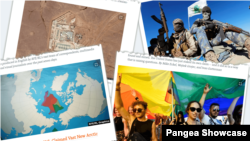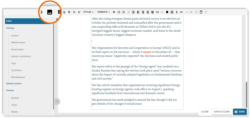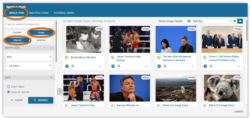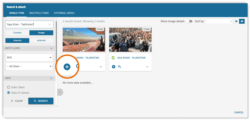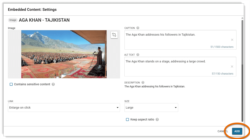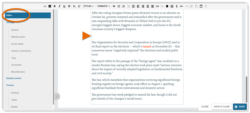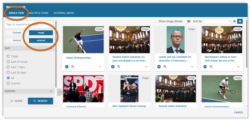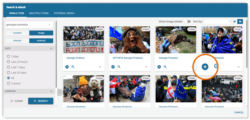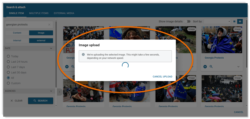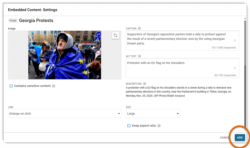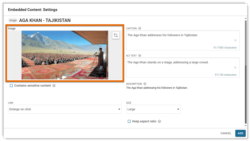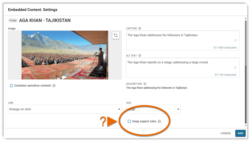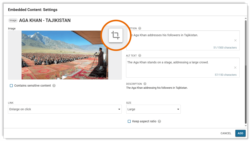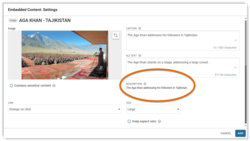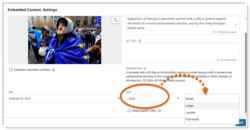What's inside this article:
- Basic information
- Embed an internal image
- Embed an external image
- Crop an image
- Adjust settings
- Special options for Feature stories
- More embeds
Basic information
This article explains how to embed an image into the body of a text content page (such as an article). When you create a text content page, you can browse and use the following types of images:
- Internal: Images that have been manually uploaded to Pangea CMS by you or another Pangea CMS user. This includes images that were uploaded by other sites and entities.
- External: Images from the following external agencies:
- AFP (Agence France-Presse)
- AP (Associated Press)
- Reuters
For details, go to the relevant section below:
Embed an internal image
You can embed an internal image that has been manually uploaded to Pangea CMS by you or another Pangea CMS user. If the image you want to use has not yet been uploaded to Pangea CMS, you first need to upload it. For instructions, see the alternative article below:
To embed an internal image:
- Click inside the main box on the Editor subpage. Position the cursor where you want to insert the image.
- Hit the Insert Embedded Content button in the text editor bar.
- Ensure Single item > Image > Internal are selected.
- Search for and select the image you want to embed. For tips and information about using Search, see the following article:
- If needed, crop the image, or adjust the settings. Then, hit Add.
You see a placeholder representing the embedded image in the text editor. The following options are available:
- (A): Edit: Adjust the settings, update the caption, or crop the image.
- (B): Image detail: Check the image metadata.
- (C): Remove: Remove the image from the page.
- (D): Insert paragraph: Insert a new paragraph below the image.
Embed an external image
You can browse and use images external images, which means images from the following external agencies:
- AFP (Agence France-Presse)
- AP (Associated Press)
- Reuters
To embed an external image:
- Click inside the main box on the Editor subpage. Position the cursor where you want to insert the image.
- Hit the Insert Embedded Content button in the text editor bar.
- Ensure Single item > Image > External are selected.
- Search for and select the image you want to embed.
- Wait while the image is uploaded to Pangea CMS.
- If needed, crop the image, or adjust the settings. Then, hit Add.
You see a placeholder representing the embedded image in the text editor. The following options are available:
- (A): Edit: Adjust the settings, update the caption, or crop the image.
- (B): Image detail: Check the image metadata.
- (C): Remove: Remove the image from the page.
- (D): Insert paragraph: Insert a new paragraph below the image.
Crop an image
Pangea automatically crops each embedded image to fit the 16:9 aspect ratio. Under Image, you see a preview of how the cropped image will look.
NOTE: More information about aspect ratio is available here.
If you are not satisfied with the default cropping, the following options are available:
Keep the original aspect ratio
Tick Keep aspect ratio to display the full image with no cropping. This is useful if you are embedding an infographic or an image with a non-standard aspect ratio (such as a vertical image).
Manually crop the image
Hit the Crop the image button to manually crop the image. While you crop, the 16:9 aspect ratio is automatically maintained. You can change which section of the image is visible, but you cannot change the aspect ratio.
Adjust settings
As well as cropping, the following settings are available when you embed an image:
- (A): Contains sensitive content: Mark images that might be offensive, disturbing, or upsetting for certain audiences. If this option is ticked, the image is censored on the public site. To see the image, visitors must manually reveal it.
- (B): Link: Specify what happens when a visitor taps or clicks the image.
- (C): Caption: Add text that will be displayed below the image on the public site. It is important to add a caption in the local language for your site. An effective caption provides context for visitors and explains how the image is relevant to the story.
- (D): Alt text: Alt text is a simple description of what is directly visible in the image. Alt text is important for SEO and site accessibility. If you do not add alt text, the Caption is used as the alt text. For detailed information about alt text with examples, see the following article:
- (E): Size: Select the image size. In most cases, you can choose Large or Small. More options are available for Feature stories.
The Description is not used anywhere on the public site. This text is provided as a source of inspiration to help formulate the caption / alt text.
Special options for Feature stories
Feature story is a special content type, intended for visual storytelling. Special size options are available for embedded images on Feature story pages.
On Feature story pages, you can choose from the following size options:
- (A): Small
- (B): Large
- (C): Jumbo
- (D): Full-size
To learn more about Feature stories, see the following article:
More embeds
The steps in this article are valid for embedding images. You can also embed the following items into the body of a text content page:
- Images: Images that were manually uploaded to Pangea CMS or images from supported external agencies.
- External media: Approved external media items (such as Facebook and Telegram posts).
- See also: Rich links to content pages published on your site or on other Pangea sites under the same entity.
For instructions, see the alternative articles below:




